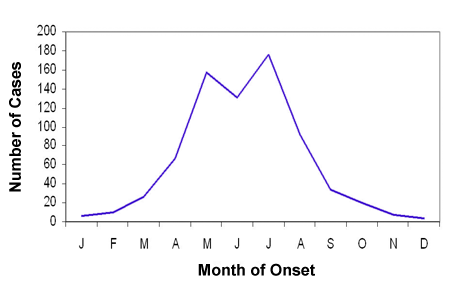Rocky Mountain Spotted Fever
HISTORY:
Howard Ricketts discovered that the bacterium
Rickettsia rickettsii was the organism that caused
organism that caused
Dr. Ricketts
-
Before antibiotics 20-25% of infected people would die from Rocky Mountain spotted fever, even today 3-5% still die but that is due to late diagnosis. This is because ticks are small and can go unnoticed for days which is when the symptom start to show up.
WHAT ACTUALLY
CAUSES ROCKY MOUNTAIN SPOTTED FEVER:
Rickettsia rickettsii live within the cells
that line blood vessels and when they leave the cell,
after reproducing new cells, they damage these
cells. This causes blood to leak through tiny holes in vessel walls into
the tissues. This leakage causes the rash that is
seen a few days after the bite and causes damage to organs and tissues.
SYMPTOMS:
About a few days to a week after the bite one can be
expected to have a fever,
severe headache, and muscle pain, followed by development of rash,
normally 2-5 days later.
The rash first appears on the ankles and wrists as faint pink 1-5 mm
spots; these spots are non-itchy.

Spots first start on the ankles and wrists and are little red flat dots.
As the disease continues to get worse the rash grows to
more area of the body, the patient gets abdominal pain, joint pain and diarrhea.
Rocky Mountain spotted fever can be a very severe illness and patients often
require hospitalization and can leave some
long-term health
problems.

As it gets worse the spots move up onto the
arms and the dots become more abundant.
WHERE?
The
states with the highest incidences of Rocky Mountain spotted fever are
WHEN?
The
amount of adult and nymphal ticks increase in the months of April- September
therefore 90% of people are infected within these months.

WHO?
Certain individuals are at higher risk of disease
like Caucasians, males, and
children under the age of 15 years, with the peak age being 5 to 9 years old.
Individuals with frequent exposure to dogs and who reside near wooded
areas or areas with high grass may also be at increased risk of infection.
TREATMENT:
DIAGNOSIS: Rocky Mountain spotted fever can be confirmed using serologic assays, indirect immunofluorescence assay (IFA), blood samples (if taken early), immunostaining of the rash.
Note: If you feel as though you or someone
you know has Rocky Mountain spotted fever, do not wait go directly to the
your doctor and get treatment.
 DRUGS:
Drugs need to be given to the
infected person or Rocky Mountain spotted fever will get extremely worse.
Treatment should not be delayed until laboratory
confirmation is obtained. Doxycycline is the most common drug
that is given to the patients.
DRUGS:
Drugs need to be given to the
infected person or Rocky Mountain spotted fever will get extremely worse.
Treatment should not be delayed until laboratory
confirmation is obtained. Doxycycline is the most common drug
that is given to the patients.
STAY SAFE FROM TICKS:
If you are going to be in an area in
which Rocky Mountain spotted fever cases have been reported you must take some
precautions to keep yourself safe. If you know you are going to be out into the
woods make sure that if you see a tick crawling on you remove it immediately.
It
may take several hours of attachment before organisms are transmitted from the
tick to the host, so don't get too scared if you find one
attached to you.
PRECAUTIONS:
-
Tuck your pant legs into your socks/shoes so the ticks on the ground or on plants will not crawl up your leg.
-
Wear light colored clothes so that ticks are easily spotted on you.
-
Bug repellants have been known to help prevent ticks from climbing on you.
-
ALWAYS ALWAYS ALWAYS do body checks after being in a grassy or wooded area. Make sure this search includes the head and any warm region on your body. Parents, make sure that you search your children for ticks just to make sure they did not miss anything.
-
Check your animals when they come in from outside to make sure they do not have ticks on them either. They could carry them inside and then the ticks could fall off and crawl on you.
REMOVAL:
-
When removing a tick do not pull on the body and do not try to burn the tick with a match, these procedure will not fully remove the tick from your body and might leave the head in you which can still infect you.
-
You need to use tweezers to get the head of the tick and gently pull out the entire tick. If you believe that the tick is infected with anything make sure that you save it and take it to your doctor for testing.
-
When you are killing the tick press a hard object on the head first and then the body; the hard shelled ticks are harder to kill.


